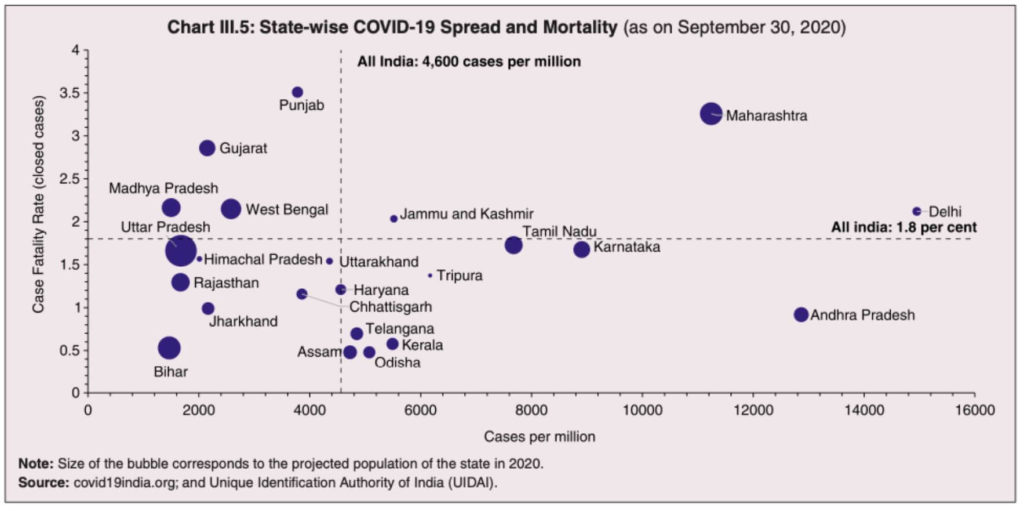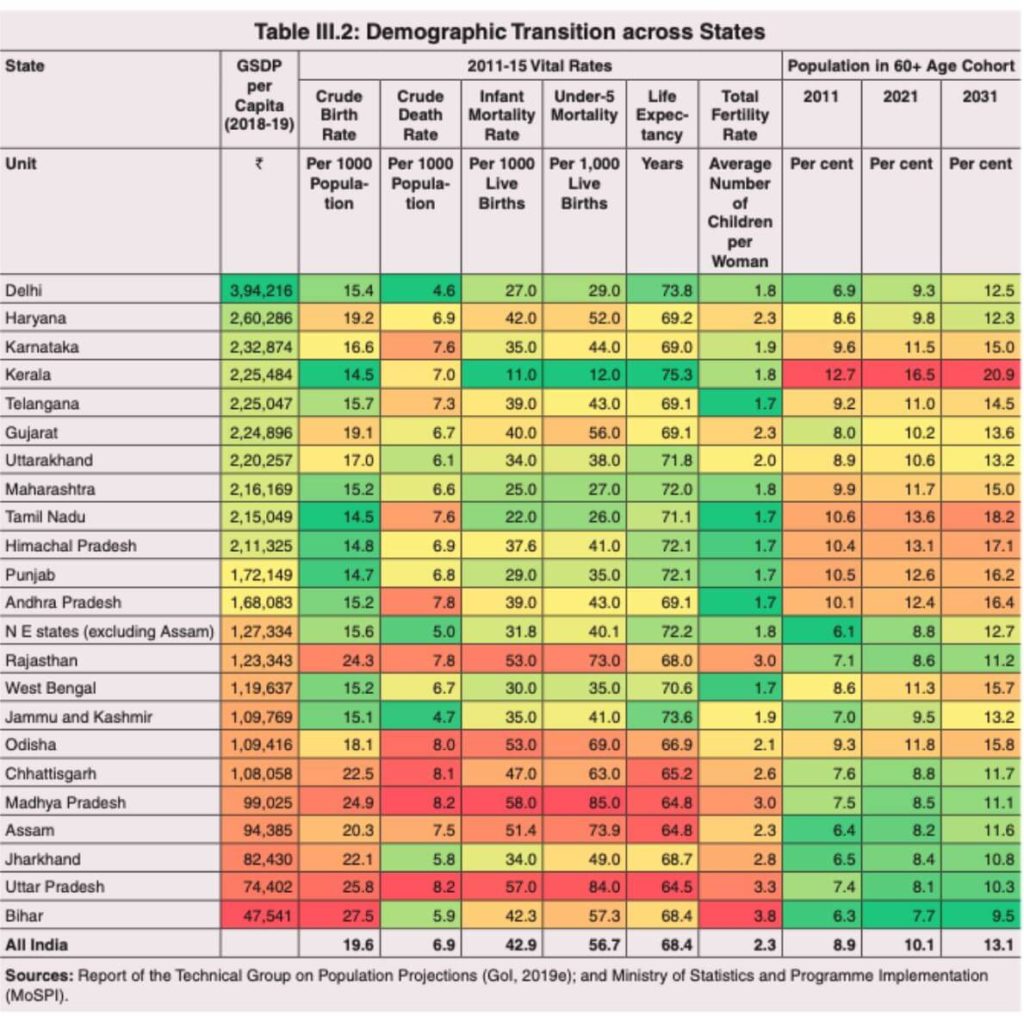The RBI, as a part of its ‘Study of State Budgets’ looked at the impact & spatial dimensions of COVID-19 on States. Among other things, the RBI looked at demographics, GSDP, health expenditure as some of the important parameters influencing COVID-19 impact on states. While UP & Bihar benefit from a lesser share of 60+ population, few other states were helped by higher per capita GSDP
India’s Central Bank, the Reserve Bank India (RBI) plays a key role in shaping the economic and monetary policy of the country. It’s standing as a centralised authority provides it with a vantage point to understand the state of country’s economy and the direction it is headed to.
The RBI regularly releases various reports based on available data and estimates, that provide an understanding of different aspects of the economy. One such is the annual ‘State Finances: A Study of Budgets’ which provides a detailed review of the financial situation of the States based on the annual budgets of the state governments.
The RBI released this year’s report on 27 October 2020. The current annual report assumes significance in view of COVID-19 epidemic and its impact on the economy of the country as well as states. Recognising the impact of COVID-19, RBI has dedicated a special section to ‘COVID-19 and its Spatial Dimensions in India’, in the state budgets report for 2020. However, it has to be noted that most State budgets were presented during Feb-March’2020, which was before the pandemic took its toll on India.
In this story, we take a look at few of the key observations made by RBI in this regard.
There is a precedence of Pandemics resulting in a negative impact on the economy
As per a press release by Ministry of Statistics & Program Implementation (MoSPI), the GDP of India contracted by 23.9% during the first quarter of 2020-21. Projections by various agencies like the IMF, OECD, Fitch Ratings etc have indicated a contraction in the economy. Factly had earlier published a story on the projections by these agencies for 2020-21 and beyond. It has to be noted that the economic slowdown is not limited to India and is part of a global slowdown due to COVID-19. Data indicates that India’s GDP growth rate is the worst among the major economies in the world for the first quarter of 2020-21.
The RBI’s report notes that an event study analysis of four pandemic outbreaks – 1896 plague, 1918 Spanish flu, 1957 Asian Flu & 1974 Smallpox, indicate a contraction/deceleration of GDP in conjecture with these events.

Among them, Spanish Flu of 1918 had the greatest impact resulting in a contraction of 13%. It ought to be noted that, Spanish Flu-1918 resulted both in greatest number of cases and deaths in India. The estimates show 125 million cases and death of 12-18 million people in India due to the Spanish Flu. In comparison, COVID-19 pandemic in India has resulted in 8.23 million cases and around 1.22 lakh deaths so far. The number of reported cases proportionate to the population was also way higher during 1918. While the current contraction by 23.9% is steeper than during the earlier pandemics, it is for a quarter and with the economy opening up post-lockdown, there are signs that economy could recover in the later quarters.
A positive aspect from the earlier precedence of pandemics is the recovery pattern. It is observed, that there is a sharp rebound following the contraction, due to the stimuli and other efforts. This is followed by contraction, and a subsequent stabilization to pre-pandemic levels within 2 years (with the exception of 1918 pandemic when it took 3-4 years).
With the current Indian economy being much larger, it is to be seen as to how quickly the country would rebound from the depths reached during the lockdowns. However, a crucial difference this time around is that the current slowdown is not only due to COVID-19, since there were indications of a slowdown even before the pandemic, due to various reasons. In this context, it is not clear whether the previous pattern of rebound would be applicable in this case also and if the time taken for stabilization would be similar to the previous occasions.
Varying Demographics of the states are influencing the impact of COVID-19 and their response
India has so far reported the second highest number of COVID-19 cases globally and has the third highest number of deaths. Meanwhile, it also has the highest number of recovered cases with a fatality rate around 1.5%, which is decreasing.
Nearly every State & UT has recorded COVID-19 cases with differences in the severity of COVID-19 infection. Maharashtra, Andhra Pradesh, Karnataka & Tamil Nadu account for nearly half of the total cases in the country, followed by Uttar Pradesh & Kerala. Apart from the absolute number of cases, larger variances exist in the rate per million, both for number of cases recorded as well as the fatality rate.
For example, although Uttar Pradesh has the fifth highest number of cases, its cases per million is less owing to its huge population.

While there are various factors which influence the extent of COVID-19 spread, the nature of demographics of the states also has a bearing on these numbers. As per the information provided by the World Health Organization (WHO), the vulnerability to COVID-19 and the mortality risk it carries is higher among older people and those with co-morbidities like Hypertension, cardiovascular diseases, respiratory diseases etc.

Therefore, the demographic profile of the state/country has a bearing on the susceptibility to COVID-19. Furthermore, the demographic profile also has an impact on the GSDP (Gross State Domestic Product) of the states, since the older population ( above 60 + years) & younger population are beneficiaries (healthcare, education ) etc. while the working age population are the donors to the state exchequer. The ratio of these population groups influences the GSDP of the state, state spending on healthcare facilities, spending capability of individuals etc. impacting the response of each of the states to COVID-19.
In other words, the nature of demographics has influence on the following.
- The extent of infection – positivity rates, fatality rates etc.
- The response to infection (recovery rates).
Few of the states like Kerala, Tamil Nadu, Himachal Pradesh, Punjab, Andhra Pradesh, Maharashtra have a higher share of 60 + population, making these states more vulnerable to COVID-19.

The extent of the 60+ population also has an influence on the imposition and implementation of lockdown & isolation measures as there is a greater need to protect this group of vulnerable population. This demographic indicator proves to be advantageous to states like Uttar Pradesh, Bihar, Madhya Pradesh etc. which have considerably a less share of the older population.
However, there is another factor which influences the isolation strategy i.e. per capita GSDP. States with higher GSDP like Delhi, Kerala, Haryana, Karnataka , Telangana, Gujarat etc. have a better ability to survive lockdown for a longer period of time with lesser impact on economy.
States which had the advantage of younger demographic like U.P & Bihar do not fare well on this aspect as their per capita GSDP is low. Furthermore, the propensity of the states to be able to spend on health infrastructure is another factor.

A combination of these factors will inform us how each of the states was impacted by COVID-19 and how they are responding.
In the next story, we would take a look at how these variances among the states had influenced the impact of COVID-19 in the areas of employment, migration of workers, MSMEs & businesses, financial transactions etc.


